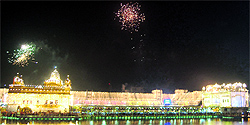Amritsar, Punjab: After failing to find a better alternative, it seems the SGPC is all set to continue with high-altitude fireworks for celebrating Bandi Chhod Diwas (Diwali) at the Golden Temple this year to minimise the threat of pollution to the holy shrine.
Talking to The Tribune, Darbar Sahib manager Partap Singh said: “If we are able to find a better option, we will go for it since we are making all efforts to curtail pollution around Harmandar Sahib”. He said they had been looking for smokeless firecrackers for the past couple of years. He said they had also tried a laser show at Anandpur Sahib once, but it didn’t meet the expectations of the Sikh sangat.
Partap Singh said they would burst fireworks at the maximum possible height and would ensure that the duration of the fireworks was between 12 and 15 minutes only. In the Guru Ram Dass birth anniversary celebrations on October 9 too, the SGPC had used high-altitude fireworks.
The Punjab Pollution Control Board (PPCB) had in 2011 advised the SGPC to ban firecrackers at the Golden Temple complex. However, the SGPC had said it was the traditional way to celebrate the occasion and the devotees sentiments were attached to it. The SGPC had, however, curtailed the duration of fireworks to 15 minutes on Diwali which was half as compared to the previous years.
As per the recent study on air pollution around the shrine conducted by the IIT, Delhi, the particulate matter (PM10) concentration breached the National Ambient Air Quality Standards (NAAQS), which was attributed by the study to high background concentrations of PM10 (55.00 µg/m3) within the city. The study found re-suspension of road dust (47 per cent), followed by industries (31 per cent) as main source of PM10. The study said diesel generators (59 per cent), vehicular exhaust (26 per cent), and free kitchen (12 per cent) were contributing to NO2 emission. Similarly, kitchen (46 per cent) and industries (41 per cent) were main sources of SO2 emission around the shrine.
Similarly, as per the PPCB study from January to December 2011, the RSPM level around the Golden Temple had come out to be a maximum of 227 and a minimum of 124, though it should not be more than 100 microgram/cubic metre around heritage sites. However, the level of sulphur dioxide (SO2) and nitrous oxide (NO2) was within prescribed limits. The high level of pollution is causing harm to miniature paintings and gold plating at the shrine, besides leading to corrosion and blackening of white marble. Its adverse effect can be seen on the gold plating on the outer walls of the Akal Takht.
The concern
- The SGPC has been looking for smokeless firecrackers for the past couple of years
- It also tried a laser show at Anandpur Sahib once, but it didn’t meet the expectations of the Sikh sangat
- The fireworks at the Golden Temple will be burst at the maximum possible height for 12 to 15 minutes
Source: The Tribune
 Sikh Sangat News Celebrating Sikh culture and sharing Sikh voices
Sikh Sangat News Celebrating Sikh culture and sharing Sikh voices

